2016 Gibson SG Standard '61 Reissue Limited Edition
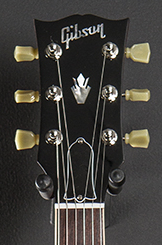
07/03/2017
BACKGROUND
Question: What do Duane Allman, Dickey Betts, Gregg Allman, Derek Trucks, Tom Johnston, Jimi Hendrix, Eric Johnson, Carlos Santana, Mick Box, Tony Iommi, Ed King, Gary Rosington, Allen Collins, Buddy Guy, Lenny Kravitz, Frank Zappa, Lol Creme, Eric Clapton, George Harrison, John Lennon, Todd Rundgren, Pete Ham, Joey Molland, Robby Krieger, Sister Rosetta Tharpe, Pete Townsend, Buck Dharma, Andrew Powell, The Edge, David St. Hubbins, and Elliot Easton have in common?
Answer: They all, at some point in their careers, played the Gibson SG. That's really not too shabby a record for a guitar with a dubious pedigree. It is general knowledge that sales of Gibson's original Les Paul were never really good in the fifties and began to lag around 1960. In order to revive sales, Ted McCarty, president of Gibson, designed a new Les Paul with a single-piece body that debuted in 1961. Les Paul's name was proudly emblazoned on the trus rod cover and a little plate at the base of the fingerboard that covered the neck tennon. Voile'! A new guitar for the new decade!!! At the launch there were four models with the "Standard" being, well, the standard version of the line. It had two PAF humbucking pickups, a small pickguard on the treble side, an ABR-1 bridge and tailpiece, trapezoid inlays, Deluxe Kluson tuners, a bound fretboard, and nickel hardware. Vavoom!
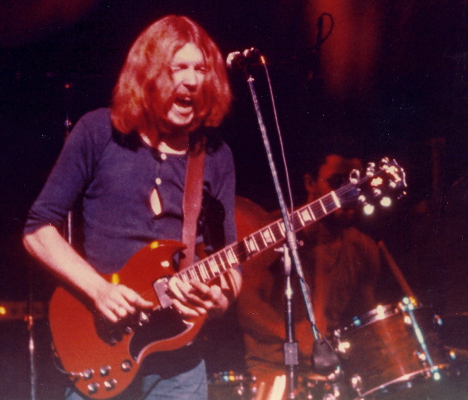
Duane Allman
There were only a few "little" problems with the arrangement:
- Ted hadn't consulted Les in the construction of his new signature guitar.
- Les was going through a divorce and needed to get his name "brand," ie. money, under control.
- Unfortunately, Les himself wasn't particularly fond of the guitar they'd put his name on.
So exactly what were Les' problems with the new guitar? He didn't feel that its unsupported, slim neck was strong enough - he felt it could be pulled out of tune. He also found that he stabbed himself on the sharpish cutaway horns whenever he quickly zipped up to the high frets. Fair enough - he did zip up and down pretty well. Les and Mary sat for the publicity pics and then moved on. Here is Les discussing his impressions of the SG, IN HIS OWN WORDS. The end resut of all this was that Les asked Gibson to take his name off the guitar. So, with blinding speed, or actually two years later in 1963 when the supply of plates with Les' name on them ran out, Gibson replaced them with blank plates and renamed the guitar the "SG," for "solid guitar." From those humble beginnings the SG has gone on to become the highest-selling Gibson electric guitar, ever. History, and a history-maker. Not too shabby, indeed.

Note non-standard strap button placement on Les'
SG Custom.
As usual for any Gibson electric guitar model, the SG Standard has been a somewhat amorphous creature - it's almost as if there really was no standard version of the guitar at all, except in the eyes of the players. Of course, this also happened with the original, maple-capped Les Paul guitar as well, which wandered around until it reached its standard configuration in 1957 but then was entirely replaced by the SG design in 1961. Then in 1966, following a call from Les Paul himself to Gibson in which he suggested they restart production of the original late 1950s Les Paul "standard" because players were screaming for it, Gibson began putting out anything but the standard configuration of the LP until the players demanded what they viewed as the exemplar, the "Standard," a Les Paul with two humbucking pickups.

Derek Trucks with '61 SG Standard Reissue
So the SG was not unique in wandering except that in its case there actually was an official, named "Standard" model right from the start. Nevertheless, somewhere along the way Gibson seems to have lost that loving feeling for the original design, as evidenced by numerous subsequent changes. Perhaps all those changes resulted from Gibson trying to keep up with the demand for the SG with its high-volume sales. Whatever the case, the mutations started in 1966, when in order to simplify construction, Gibson introduced a version with a larger pickguard that incorporated the pickups. Players quickly dubbed the new pickguard the "batwing" guard. Through the '70s Gibson experimented with different pickups and body woods and in the '80s the guitar suffered similar attempts to modernize it. It sometimes feels as if whenever a new idea blows through, they try it on the SG first.
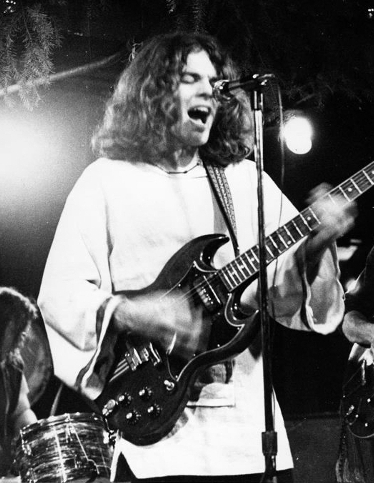
Tom Johnston with batwing SG
Eventually in the '90s, when there was a loud enough outcry from guitarists who wanted the SG Standard, the standard Standard, the guitar as it appeared in 1961, Gibson created their SG Standard '61 Reissue USA model in an attempt to return to something resembling the original specifications. Of course, there were still little tweaks to the design such as the "Nashville" bridge with its large studs and long saddle travel. The '61 Reissue was marketed as slightly upscale from most of the other SG models and cost a little more than they did. Eventually in 2014, after fourteen years of success, Gibson decided to move on to something new and discontinued the '61 Reissue from the USA line once again. Oh, it did reappear for one year in 2016 in the Custom Shop line as the "Custom Historic SG Standard," so you could have one for more than twice the cost of the former USA model. At the same time, every USA SG model was invested with some funky do-daddery: GForce robo-tuning, hot pickups, alternate tailpieces, alternate finishes, fat necks, deleted poker chips, alternate inlays, alternate pickguards, or weird chromed accents. It all reminded me of some automobile conglomerates that have upscale brands that simply take the baseline car and tart it up with fancier chrome or bodywork. In those cases and in the case of the SG, I've always been drawn to the basic model. For some reason it always appeared to me that the designers started on that basic model and the design always made the most aesthetic sense in that form.
What was it about the original SG that everyone loved? Well first off, it was a very light guitar. For its period it was a pretty radical aesthetic design, as well. The two cutaways were formed into pointed horns and much of the perimeter of the body was trimmed with bevels. It is unclear whether the bevels were intended to make it comfortable, or to possibly surf Fender's zorchy, body-hugging curves. Perhaps they were a result of Gibson trying to add an upscale, well-designed look to the proceedings at the launch, because the original Les Paul had been marketed as an upscale guitar. But whatever the case, they turned the guitar into a very comfortable instrument. One feature of the original SGs was the slim neck with access way up to the highest frets. Initially all that slimness and access came at a cost: there were problems with necks breaking at the headstock and the heel joint. That precipitated a scramble at Gibson to re-engineer the neck joint after the first units shipped.. The space between the fingerboard and the neck pickup was trimmed with a little plastic plate between the pickup and the fingerboard.
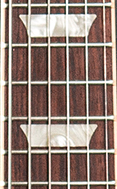
ON THE HUNT
For some reason I recently began sniffing around the SGs. What is wrong with me? Well, here is the deal, and it is a pretty good reason: I have a Les Paul with humbuckers and another with P-90s. I have an ES-335 with humbuckers and a Strat and a Tele with their respective single-coil pickups. They all fill their niche's well. But there was a middle ground I was looking for: I wanted a guitar with upper-mid cut like the P-90 equipped LP or the Tele but that had humbuckers to remove the hum. I'll be honest: I spent years playing on humbuckers so I'm spoilled rotten when it comes to having a quiet background without hum and buzz. A lot of my work goes to tape so I need a quiet guitar for recording. After years with Gibsons as my home base I am also really very much at home with Gibson's 24.75" scale. That led me to scratch my head and look at the mahogany-bodied Gibsons, and to wonder whether the SG might fill the bill.
Right about at that time, a used 2005 SG Standard '61 Reissue showed up at a local dealer. When I pulled ot off the wall and tried it I was quite impressed. People said the 2005-2006 era was a good cutoff point because after that point some of the characteristics of the guitar began to wander again. A few days later I was ready to pounce but the guitar had been snapped up by someone else... that very morning. Disappointment!!! A few days later while on a trip, I visited this great little used and vintage guitar store in Knoxville, TN, called Music Room Guitars & Records. On their wall I found another one, this time a 2006 model with specs identical to the 2005. It sounded and felt every bit as good as the 2005 model and was priced right. I usually think about these things overnight so I made up my mind and called to hold it the next morning. Surprise! It, too, had been sold right out from under me.
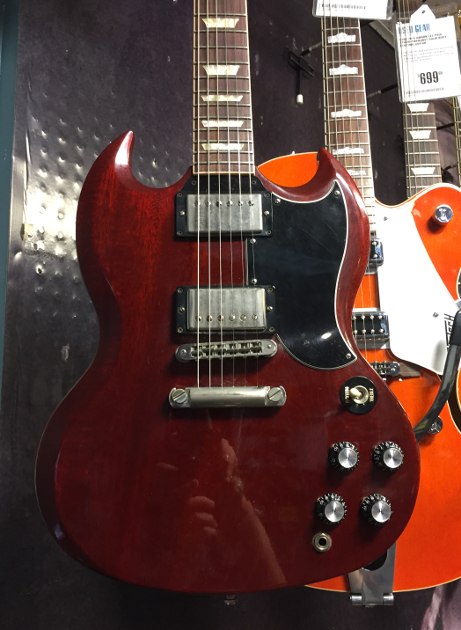
Used SG, the first
At this stage in my life I tend to think these things happen for a purpose, so I don't get terribly disappointed. At that point a helpful soul on a forum suggested I look at the 2016 Limited Edition SG Standard '61 Reissue from Dave's Guitar Shop and Sweetwater. This model was created in response to the Reissue model's cancellation and amid continued demand from traditionalists. Two dealers, Dave's Guitar Shop of LaCrosse, WI, and Sweetwater Sound, Inc. of Fort Wayne, IN, got together and commissioned this short-run in an attempt to go back and really capture the guitar as it was in 1961. I've been told that Gibson short runs require at least twenty-four guitars, so perhaps we've got some ballpark idea of the number of units for the run, or at least the lower limit.
I started my quest by taking a look on Sweetwater's site and watched their last one disappear right before my eyes. Hmm... Is a pattern emerging here? Next, I checked Dave's site. Lo' and behold they had two, at least until I got interested, and then one suddenly disappeared. Time to move. This remaining one was the very last one of the series. I called and negotiated a deal and then went to lunch while waiting for an email with a PayPal invoice. When the salesman called me back I was on the road so I just pulled my car into a parking lot and conducted the PayPal transaction right from the driver's seat. Whew! I finally nailed down an SG. Five days later it arrived at my doorstep. After a little tussle with runaway styrofoam peanuts I was able to unpack it.
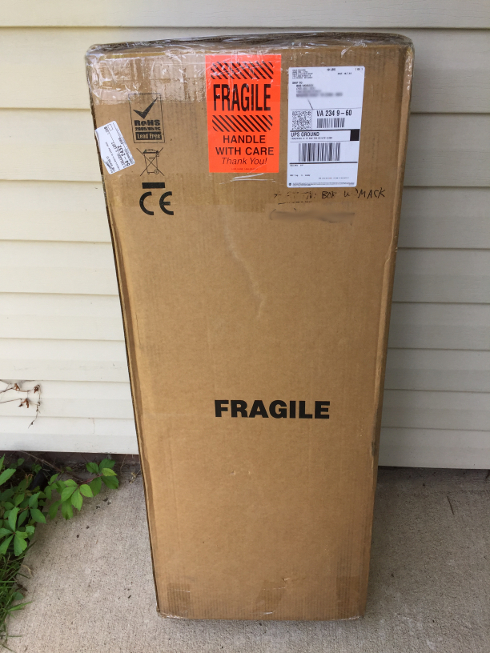
THE ITEM IN QUESTION
So, what makes this edition special? Dave's Guitar Shop designed this run of classic-styled SGs and went right back to the original specs: Small "angel wing" pickguard and body-mounted pickups, '57 Classic (neck) and '57 Classic Plus (bridge) pickups, an ABR-1 bridge, classic-style Deluxe Kluson tuners with pearloid tulip-shaped buttons, nickel-plated hardware, jumbo frets in a bound rosewood fingerboard, trapezoidal inlays, reflector knobs, and a brown-and-pink Gibson USA hard case with dual-block neck support. The case candy included an allen wrench, a trussrod wrench, a cleaning cloth, the inspection record, an owner's manual, and a warranty card. As a little extra personal touch, the inspection card was wrapped around a photo of the guitar on the inspector's work bench at Gibson. Dave's also included their own inspection card and some nice case candy.
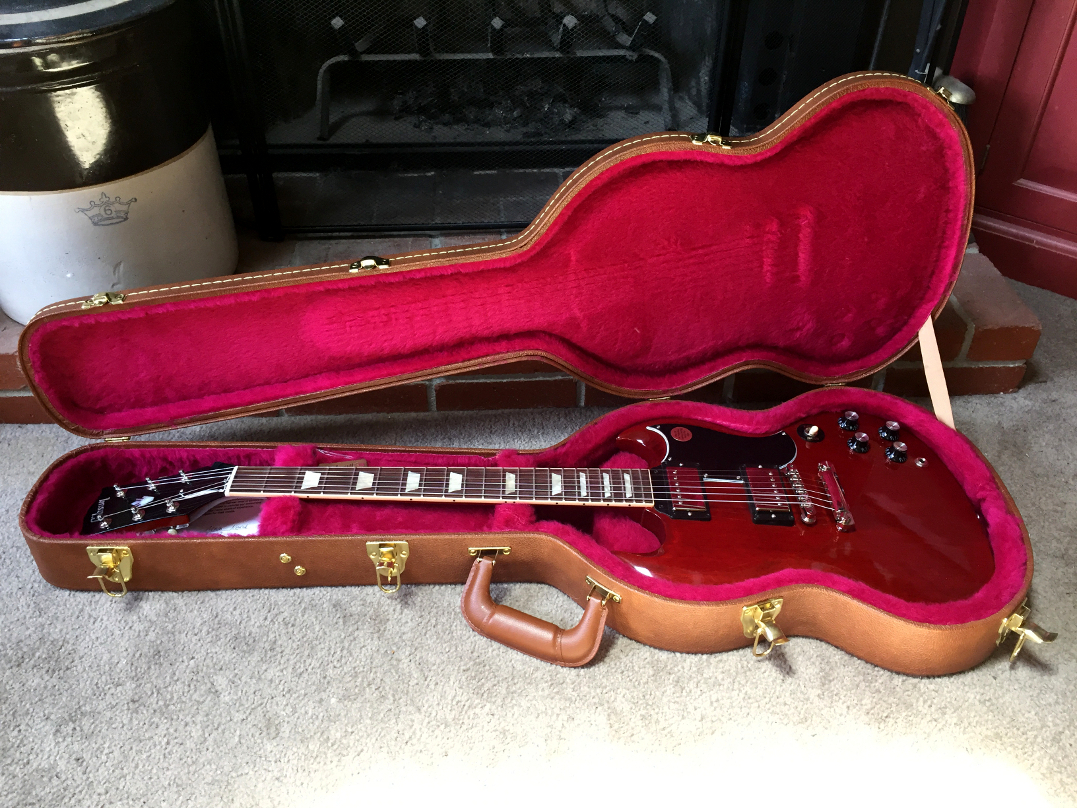
SO HOW DOES IT SOUND?
The sound is slimmer and less rounded than that of a typical maple-capped Les Paul and projects quite a bit more overtones and "bite." Of course that means that the bass you've had to carve out of your typical LP sound doesn't need to be carved out for the SG. The '57 Classic (neck) and '57 Classic Plus (bridge) pickups give it great articulation and smooth character. As with other '57 Classics, I find that I need to back off the bridge pickup tone control to about five or six to smoothly switch between the two pickups. The '57 Classic Plus in the bridge position doesn't feel like it has that much more gain, just more "meat" and overtones. The tone of the guitar is in the range of an ES-335 but without the airy sweetness that the ES-335 possesses due to its body resonance. The impression is of "stringiness," meaning that throughout the gain range from clean to overdriven, the overtones and individual-string definition stand out. There are those who argue that once you gain up the amp a little, all electric guitars sound the same. There is no better foil for this argument than a comparison between the SG and Les Paul. A standard maple-capped Les Paul tends toward a more chesty, midrangy sound, especially on the neck pickup. As you push into overdrive you sense a blending together of the individual strings in a chord into a singular sound. If you need girth, that's the place to go. By contrast, the SG tends to keep the string sounds more separate even as the overdrive comes on. It is a more throaty sound. The upper-midrange "bite" lingers as well and the lower-mids don't pile on. There's also less sustain on the SG than on a Les Paul. Don't go away and get a sandwich and expect the SG to still be sustaining when you come back, Nigel. Horses for courses. The guitar has a certain cool "gnarliness " to it - it seems perhaps a little meaner than either a Les Paul or an ES-335, if you will.
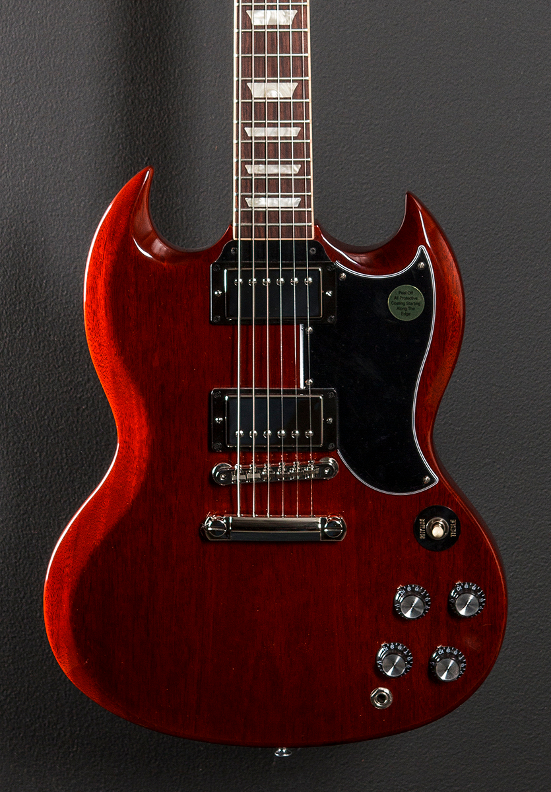
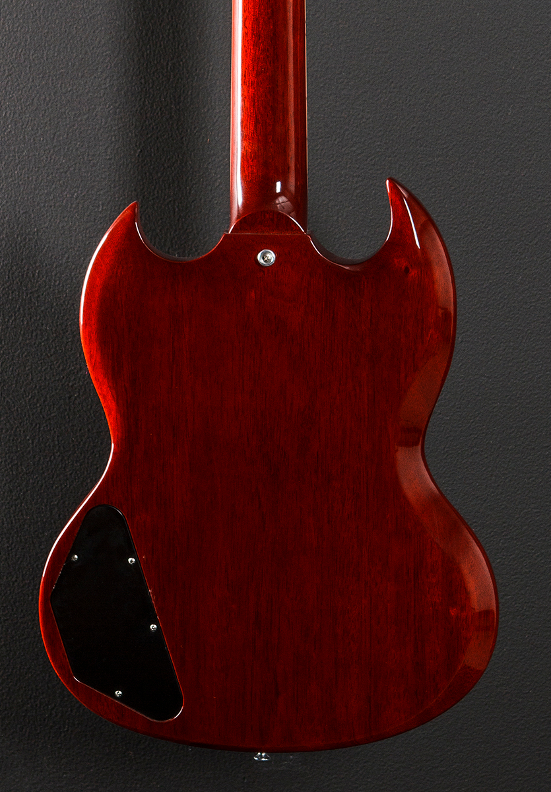
Dave's Pics. Click to enlarge. The light specks on the pics aren't on the guitar.
Whenever I sit down with new guitars, each one seems to suggest some sounds that are tucked away in my memory. This guitar is no exception. As I was fiddling around with various amounts of gain and playing parts from songs with the neck pickup selected, the plantive, single-string lead sound from the break in Three Dog Night's "Out in the Country" just popped out. I did a finger slide from the fifth to the seventh fret and back on the high E string. Yep. That's the sound. It all makes sense if you go back and look at the album cover for the band's Captured Live at the Forum album because you can see that guitarist Michael Allsup was using an SG in that period. Very tasty! Pop out a glass slide and dial up moderate gain on the neck pickup and Derek Truck's various sounds from the Soul Serenade and Revelator albums come tumbling out really quickly. And then there was another lead that just popped out. Remember that little lead break in the song, "Get Back," by the Beatles? Yep, when I was testing out the guitar at my luthier's shop that just fell out of the guitar as well.
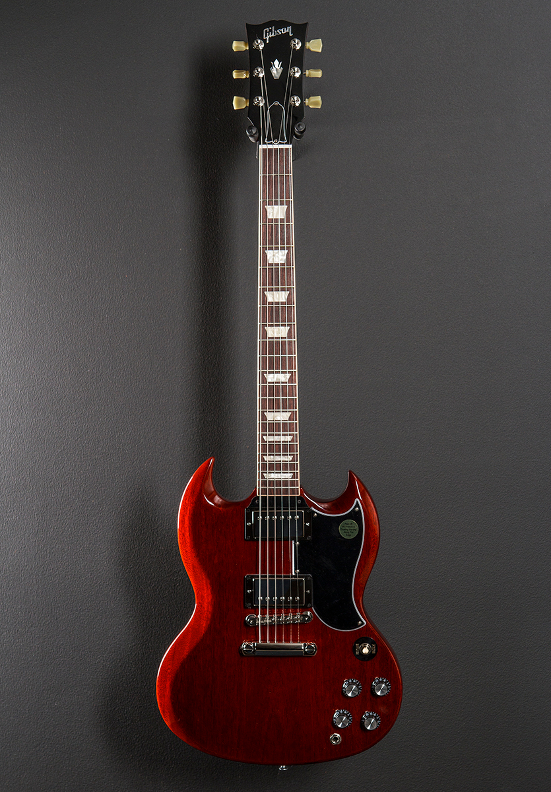

Dave's Pics. Click to embiggen.
AND HOW DOES IT FEEL?
The weight of this example is a comfortable 6.6 pounds and the guitar is very well-balanced. It neither nose-dives continually towards the headstock nor tips backwards towards the lower bout like a heavy Les Paul does. In fact, it nose-dives less than a light, chambered Les Paul Studio I have. Much like a Stratocaster, it sort of molds to your body and feels quite comfortable sitting in your lap. For such a lightweight, the guitar is amazingly resonant and sustains well. Perhaps that has something to do with the solid, one-piece mahogany body. As delivered, the fingerboard and jumbo frets feel pretty fast and Gibson's use of the Plek machine makes the frets and fretboard fairly consistent for a production guitar. The neck is slim from front to back but has some meat at the shoulders that keeps it from feeling too slim in your hand. The profile is something like a Memphis ES-335 DOT Reissue. The shoulders are also comfortably rounded towards the fingerboard. A guy like me with a light touch doesn't notice any limp-neck syndrome - I don't find the guitar detuning with hand pressure. Perhaps that's the point of the meaty shoulders.
String height? That's pretty subjective, but I can tell you I don't typically like an ultra-low action. Nevertheless, for my tastes, the string action on this guitar arrived a little tall. I was able to pull off a couple of 64ths at the bridge with the thumb wheels and make things a little better but the height at the nut was also a couple of 64ths higher than I prefer and the strings slots were pretty shallow. Of course, delivering a guitar with a slightly high action is the wise thing for a builder to do: It is always less expensive for a tech to lower the action at the nut to a particular player's personal taste than it is to raise it, so manufacturers want to ship guitars a bit higher rather than lower to suit as many tastes as possible, as inexpensively as possible. I took it 'round to my luthier, Kenny Marshall, to finish the setup and he was able to improve on it considerably. Kenny found some inconsistancies on the upper end of the fretboard and around the fifth fret and was able to work them out to create a more consistant action and one that is less "slappy." By the time he dressed the frets we ended up with about .050 fret height overall and about 2/32" action at the twelfth fret. Kenny also rounded the fret profiles nicely so that I can slide up and down the fretboard smoothly and without effort. The intonation that was off from the factory ended up really true. As always, my investment in an initial setup and fret dressing paid off handsomely. Thanks, Kenny!
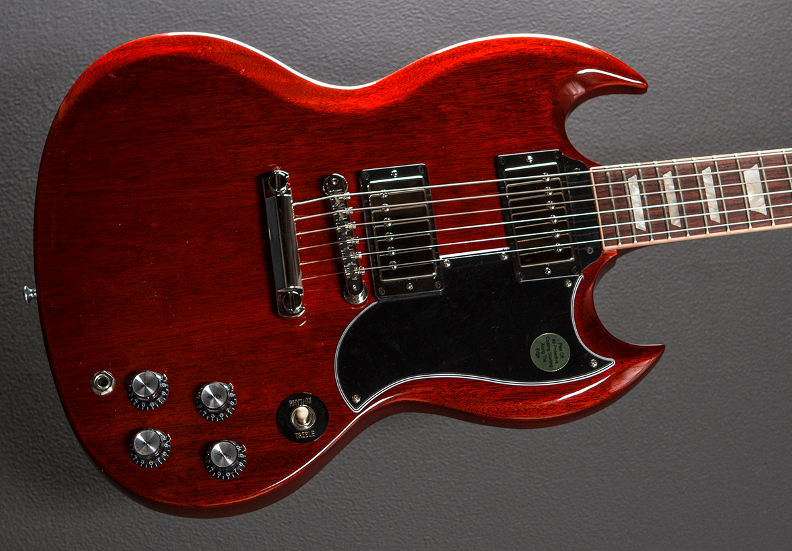
Dave's Pic. Click to embiggenate. The light specks on the pics aren't on the guitar.
FIT AND FINISH?
Is it me or has Gibson recently upped its finish game? I suppose it could be attributed to the fact that this was a limited edition short run but this guitar exhibits really nice finish work. There is little or no orange peel, just the tiniest wobble on the upper edge of the headstock. The guitar shows extremely nice attention to detail as well. Surprisingly, the fingerboard has none of the scrape marks that bound Gibson fretboards are famous for. The one oddity (there always is one) is a tiny (pinhead sized) spot of Heritage Cherry finish on the side of the black headstock overlay. Picky, picky, picky. If I didn't love hand-made guitars I might be bothered. But I do and I'm not. Call it a character mark.
* CONCLUSIONS *
So, how does it all add up? From my perspective this is a great guitar and a great package. Dave's and Sweetwater did a fine job returning to the original specs and Gibson did a nice job executing the run. The result is a solid guitar that plays well and sounds marvelous. It falls right into the niche I was hoping it would, between the ES-335 and the Tele and near the Les Paul with P-90s. It gives plenty of high-end snap and bite and can get rather raunchy like a guitar with P-90s, while still being capable of a mellow sound and while avoiding their hum and noise. All of this came at a very reasonable price point as well. So what's missing? How about the Les Paul name on the trussrod and tenon covers? How about twice the price for a Custom Shop* version? That's about all this guitar is missing, and in my eyes, ears, and hands, that makes it a great guitar.
Specs for the reviewed example:
2016 Gibson SG Standard '61 Reissue Limited Edition
Heritage Cherry Gloss nitrocellulose lacquer finish
Solid (one-piece) mahogany body
One -piece mahogany neck
Bound 12” radius rosewood fingerboard with trapezoid inlays and jumbo frets
Mother of Pearl Gibson logo and "holly" inlay on headstock
’57 Classic Plus bridge pickup and ’57 Classic neck pickup
ABR-1 tune-o-matic bridge and stop tailpiece
Gibson Deluxe Kluson vintage-style tuners with pearloiod tulip-shaped buttons
Small five-ply "angel-wing" pickguard
Black reflector knobs
Brown and pink arched-top hardshell case with a nice gold STEAL ME Gibson USA logo
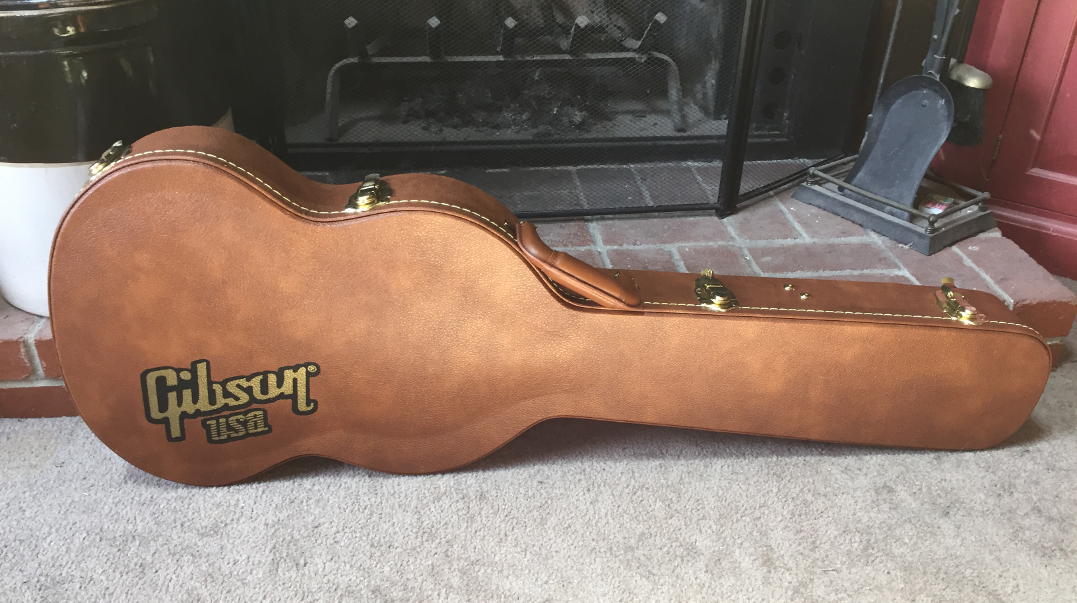 Resting by the hearth. And who doesn't like to?
Resting by the hearth. And who doesn't like to?

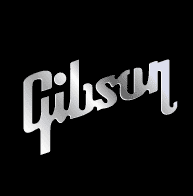
* The news from Gibson is that their Custom Shop has ceased it's reissue lines so who knows when a guitar like this will be available next?
= =
=

















